Fauré's Requiem
Gramophone
Tuesday, February 3, 2015
Recommended recordings of Fauré’s Requiem
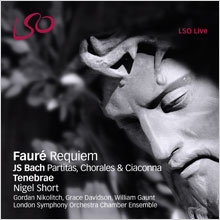
The Gramophone Choice
Requiem (1893 version, ed Rutter)*
Coupled with JS Bach Solo Violin Partita No 2, BWV1004 and Chorales
*Grace Davidson sop *William Gaunt bar Gordan Nikolitch vn Tenebrae; London Symphony Orchestra Chamber Ensemble / Nigel Short
LSO Live LSO0728 (68’ • DDD/DSD • T/t) Recorded live in May 2012. Buy from Amazon
The usual suspects to pair with Fauré’s Requiem – Cantique de Jean Racine and Messe Basse – get more exposure than their musical quality justifies, so it is good to have this unique coupling on disc, even if, at first sight, there is no obvious logic behind it. Certainly prefacing the Fauré with Bach’s violin Partita No 2 got everyone firmly in the D minor mood for the live concert, while Gordan Nikolitch’s extravagantly expressive approach, oozing rubato out of every bar, established an atmosphere of late-19thcentury romanticism. On top of that, peppering the movements of the Partita with various chorales gave the choir a good warm-up, even if superimposing these over the Chaconne, for all the academic justification in the booklet, comes across on disc as if soundproofing was a problem and the microphones accidentally picked up strains of a distant choir.
But with the unbroken segue into the Fauré, everything falls perfectly into place. Perhaps because there is a clear link between the two – psychological rather than musical – the performance is elevated into something quite remarkable; there's little hesitation in labelling this the very best Fauré Requiem on disc.
This may be the pared-down Rutter version of the Requiem but, given the grand spaciousness of the recorded sound and Nigel Short’s expansive approach, it is a performance of extreme richness and opulence. Short’s marvellously moulded phrases, long-drawn and exquisitely shaped, as well as his penchant for expansive crescendos (most potently displayed at ‘Lux aeterna luceat eis’), in which James Sherlock leads the way brilliantly with some breathtaking manipulation of the St Giles’ Cripplegate organ, are vital elements in elevating this performance to the sublime.
Not to be downplayed, however, is the exquisite singing of Tenebrae, the magical violin luminously hovering over the Sanctus like an angel in the clouds, instinctively warm and sympathetic orchestral playing and, above all, absolutely gorgeous singing – object lessons in understatement and poise – from both Grace Davidson and William Gaunt. In short, this is a devastatingly beautiful performance.
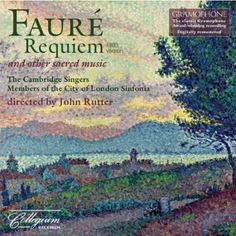
Additional Recommendations
Requiem (1893 version, ed Rutter)
Coupled with Motets – Ave verum corpus; Tantum ergo; Ave Maria; Maria, mater gratiae. Cantique de Jean Racine, Op 11 (orch Rutter). Messe basse
Caroline Ashton, Ruth Holton sops Stephen Varcoe bar Simon Standage vn John Scott org Cambridge Singers; City of London Sinfonia / John Rutter
Collegium CSCD520 (63‘ · DDD · T/t). Recorded 1984. Buy from Amazon
Fauré began his Requiem in 1885, under the impact of the death of his father, but the work didn’t take on the form in which we now know it until 15 years later. The familiar 1900 score, therefore, can’t really be regarded as ‘definitive’; it’s a compromise, rather, between Fauré’s original conception and what his publisher no doubt saw as the practicalities of concert performance. It’s Fauré uncompromised that John Rutter has sought to restore in his edition of the seven-movement 1893 version, and his performance of it, using a chamber orchestra, a small choir and, in the ‘Pie Jesu’, a soprano who could easily be mistaken for a treble (Fauré’s own early performances used a boy soloist) is a most convincing argument for accepting this score as more ‘authentic’ than the customary 1900 version.
The differences are audibly obvious, and most are no less obviously improvements. The almost omnipresent organ now sounds more like a continuo instrument than (as can easily happen with the 1900 score) an unwelcome thickening of an already dark orchestra. Above all, one is more aware than in any other recording that the sound in Fauré’s head when he conceived the work wasn’t that of a conventional orchestra but the rich, dark graininess of divided violas and cellos, the radiant luminosity of the work provided not by violins or woodwind but by the voices. It’s thus more unified than the later revision as well as being more intimate. Rutter’s chorus is a fine one, immaculate of diction and pure of line; Stephen Varcoe’s light and unforced baritone could well be just what Fauré had in mind and Caroline Ashton’s absolute purity in her brief solo is most moving. The recording is excellent.
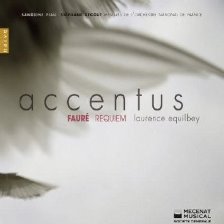
Requiem (1893 version).
Coupled with Cantique de Jean Racine, Op 11
Sandrine Piau sop Stéphane Degout bar Maîtrise de Paris; Accentus Chamber Choir; French National Orchestra / Laurence Equilbey
Naïve V5137 (41’ · DDD). Buy from Amazon
Can there may be a more profoundly beautiful recording of Fauré’s Requiem out there? We defy any sensitive soul not to be transported into a state of near rapture by the unspeakably delicious Sanctus, the solo violin of Luc Héry floating ethereally above the choral and orchestral textures like a skylark in full song.
What is it that makes this such a sublimely beautiful recording of a work which, let’s face it, is more than generously represented in the catalogues? (For the record, this is the original scoring of the work – organ with chamber orchestra minus violins – which was finally published in 1969.) It’s not just the lovely sound produced by the three dozen voices of Accentus, unquestionably one of the really top-notch choirs around at the moment, or the angelic voices of the Maîtrise de Paris which point us heavenwards in the closing In paradisum. Nor can the credit for such unremitting loveliness be laid wholly at the feet of the members of the Orchestre National de France, handling this famous score with rare sensitivity and delicacy, or the wonderful pair of soloists. Stéphane Degout brings immeasurable poise to the Hostias, while Sandrine Piau’s 'Pie Jesu' has a wholly unaffected aura of purity and innocence – and has the string response to each line ever before been captured on disc with such utter gentleness?
These are all exceptional elements, but the two things which transform this are the recording’s location and Laurence Equilbey’s inspired direction. The famous Parisian church of St Clotilde imbues the whole thing with an atmosphere of warmth and great tranquillity, the organ pedals perfectly proportioned (and superbly captured by the Naïve engineers), while Equilbey shapes and caresses every single phrase, every line, every note with the kind of loving care few conductors ever lavish on such a well known and technically undemanding score. The result is a genuinely revelatory reading.
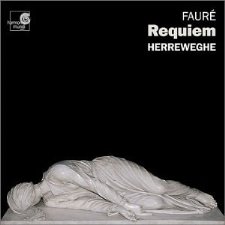
Requiem (1890 version)*
Coupled with Franck Symphony in D minor
*Johannette Zomer sop *Stephan Genz bar *Collegium Vocale; a La Chapelle Royale; Champs-Elysées Orchestra, Paris / Philippe Herreweghe
Harmonia Mundi HMC90 1771 (76‘ · DDD · T/t). Buy from Amazon
Philippe Herreweghe’s earlier recording of the Fauré Requiem (also Harmonia Mundi) used Jean-Michel Nectoux’s edition of the original 1891 ‘chamber’ score. This is the familiar 1900 version, with its full if curious orchestration, but in other respects this is a more ‘authentic’ reading than the earlier one. Period instruments are used, gut strings giving the sound a gentle luminescence, and instead of an organ, Fauré’s permitted alternative, a large harmonium, adds a reedy quality to the wind scoring. A shade more controversially, the work is sung in ‘Gallican’ Latin – ‘Pié Zhesü’ instead of ‘Pie Yesou’, ‘Lüx perpétüa’, and so on. Together with the other period details it makes the work sound distinctly Gallic: an admirable antidote to the Anglicised or even Anglicanised Fauré presented by the archetypally English cathedral and college choirs that have so often recorded it. Both soloists are excellent, Herreweghe’s tempi are a little more alert than before and the recording is splendidly ample.
Alongside gut strings, the big advantage of a period orchestra in Franck is the beautifully smooth sound of the horns. The overall sound is more transparent than usual, and Franck’s reputation for dense over-scoring seems more than ever unjustified. It’s a fine and idiomatic performance and hugely enjoyable.
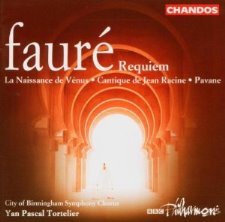
Requiem (1900 version)*
Coupled with Pavane, Op 50. Cantique de Jean Racine, Op 11. La naissance de Vénus, Op 29**
*Libby Crabtree, **Mary Plazas sops **Pamela Helen Stephen mez** Timothy Robinson ten */**James Rutherford bass-bar City of Birmingham Symphony Chorus; BBC Philharmonic Orchestra / Yan Pascal Tortelier
Chandos CHAN10113; CHSA5019 (70‘ · DDD/DSD · T/t). Buy from Amazon
It was the French music publisher Hamelle who suggested that Fauré expand his ‘petit Requiem’ (1893 version – as restored by John Rutter) into a ‘version symphonique’ (1900). However, if you like Fauré’s evergreen sung by a large chorus supported by symphonic-strength strings and brass then this new recording will suit nicely.
The disc’s sound is consistently warm, reverberant and engaging. The chorus are in committed form: unanimous, well blended and balanced. Aside from one ugly glitch from the sopranos in the Requiem’s Sanctus (‘hosanna-RIN-excelsis’), they should be congratulated on their clear diction. Unlike Philippe Herreweghe’s ‘authentic’ recording, no attempt has been made to sing the Latin text with a French accent. Yan Pascal Tortelier’s tempi are perfectly sensible, though the opening Kyrie is well below the metronome marking. Both soloists control their fervour admirably, and organist Jonathan Scott conjures up a wide variety of (presumably) electronic organ tone, including a delicious harmonium-type combination in the ‘Pie Jesu’.
The enjoyable makeweights Pavane and Cantique de Jean Racine both breathe the calm air of the Requiem. But the disc’s revelation is a wonderful performance of the rarely heard La naissance de Vénus, a 23-minute ‘mythological scene’ completed in 1895. It’s a little gem.
Coupled with Fauré Pavane & Duruflé Requiem
Sir David Willcocks
EMI 764715-2 (42’ · ADD). Buy from Amazon
A much-loved LP version, documenting the excellence of the King’s College Choir at its mid-1960s peak, and still sounding well. Robert Chilcott and John Carol Case are the excellent soloists.
Coupled with Fauré Cantique de Jean Racine & Messe basse. Poulenc Choral works
George Guest
Decca 436 486-2DF2 (149’ · ADD). Buy from Amazon
Fresh, vivid and relatively small-scale, the Choir of St John’s College, Cambridge, as taped in 1975, shines in a twofer of French choral classics.
Coupled with Fauré Pavane; Koechlin Choral sur le nom de Fauré; Schmitt In memoriam Gabriel Fauré – Scherzo; Ravel Pavane pour une infante défunte.
Sir Neville Marriner
Philips 446 084-2PH (55’ · DDD). Buy from Amazon
With Sylvia McNair and Thomas Allen the outstanding soloists, Sir Neville Marriner’s 1993 version uses the fuller orchestration but never lets the music drag. His unusual makeweight is a select group of French orchestral miniatures, exquisitely played.











